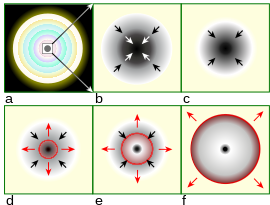| This article needs additional citations for verification. Please help improve this article by adding citations to reliable sources. Unsourced material may be challenged and removed. Find sources: "Collapsar" – news · newspapers · books · scholar · JSTOR (April 2022) (Learn how and when to remove this message) |

A collapsar is a star which has undergone gravitational collapse. When a star no longer has enough fuel for significant fusion reactions, there are three possible outcomes, depending on the remnant star's mass: If it is less than the Chandrasekhar limit (1.4 solar masses), the star will stabilize and shrink, becoming a white dwarf; between the Chandrasekhar limit and the Tolman–Oppenheimer–Volkoff limit (approximately 3 solar masses), it will become a neutron star; and above the Tolman–Oppenheimer–Volkoff limit, the star will become a black hole. However, it is theorized that the high density of neutron star cores allow for quark matter and, as a result, a star that is more massive than even the Tolman–Oppenheimer–Volkoff limit, yet still is not a black hole.
See also
References
- "COLLAPSAR | Meaning & Definition for UK English | Lexico.com". Lexico Dictionaries | English. Archived from the original on March 23, 2022. Retrieved 2022-03-23.
- Rueda, Jorge A.; Ruffini, Remo (2012). "On the Induced Gravitational Collapse of a Neutron Star to a Black Hole by a Type Ib/C Supernova". The Astrophysical Journal. 758 (1): L7. arXiv:1206.1684. Bibcode:2012ApJ...758L...7R. doi:10.1088/2041-8205/758/1/L7. S2CID 119103016.
External links
| Stellar core collapse | ||
|---|---|---|
| Stars |  | |
| Stellar processes | ||
| Collapse | ||
| Supernovae | ||
| Compact and exotic objects | ||
| Particles, forces, and interactions | ||
| Quantum theory | ||
| Degenerate matter | ||
| Related topics | ||
This article about stellar astronomy is a stub. You can help Misplaced Pages by expanding it. |